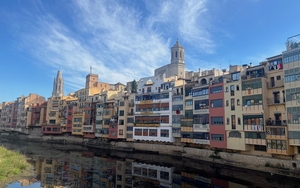WHITWORTH ART GALLERY has the first UK showing of Idris Khan’s new installation The Devil’s Wall (2011).
During this act, pilgrims chant and throw seven stones at three walls in three different locations, each of the walls representing the devil.
This draws inspiration from rituals and practices of the Hajj, the pilgrimage to Mecca that is one of the seven pillars of Islam and is undertaken by millions of Muslims each year.
Exhibited in the Whitworth’s Mezzanine Court, these three new sculptures and a series of drawings are based on an aspect of Hajj ritual where pilgrims are encouraged to turn their attention inward through physical action, contemplation and meditation, with the aim of bringing them closer to the divine.
Khan’s artistic practice follows patterns and rules that blur the cultural boundaries between the secular and spiritual. He uses repeated actions and engraved or printed words to explore his Islamic heritage.
The first elements of the installation are three large, black, cylindrical sculptures, each with a central, downward sloping funnel. Radiating out from, and sometimes plunging into, the dark centre of each sculpture are selected texts from the Quran in Arabic and English, sometimes in distinct lines but also sometimes overlapping each other.
These sculptures are created in reference to the ritual stoning of the Jamarat, an important part of the Hajj pilgrimage that takes place in Mina, East of Mecca. During this act, pilgrims chant and throw seven stones at three walls in three different locations, each of the walls representing the devil. The ritual symbolises the sufferings experienced by the prophet Ibrahim when he had been asked by Allah to sacrifice his own son to prove his devotion.
For these sculptures, Khan has not referenced the three walls of the Jamarat directly, but instead the cylindrical forms of the works allude to the circular dishes into which the stones gather after hitting the walls.
The gesture of throwing is central to this work in the artist’s focus on transferring thoughts into objects and text. Khan engraves texts into the black-painted metal surfaces and the words curve through space, subtly disappearing into the central vortex of each sculpture.
![Making_The_Work-_Idris_Khan,_The_Devil's_Wall,_2011._Courtesy_Of_Victoria_Miro_Gallery,_London_And_Yvon_Lambert_Gallery,_New_York[1] Making_The_Work-_Idris_Khan,_The_Devil's_Wall,_2011._Courtesy_Of_Victoria_Miro_Gallery,_London_And_Yvon_Lambert_Gallery,_New_York[1]](https://assets.confidentials.com/uploads/imported/i/IJB/4O9P_K.jpg) Making The Work, Idris Khan, The Devil's Wall. Courtesy Of_Victoria Miro Gallery, London And Yvon Lambert Gallery, New York
Making The Work, Idris Khan, The Devil's Wall. Courtesy Of_Victoria Miro Gallery, London And Yvon Lambert Gallery, New York
The same ritual theme using repeated texts is present again in the seven drawings exhibited, selected from a series of 21 drawings, called 21 Stones.
These drawings, comprising lines of text printed using wooden stamps, were a new medium for the artist when they were made in 2011.
Khan includes both personal statements and quotations from the Quran, in Arabic and English, printed repeatedly in a circular, mandala-like pattern, evoking the sensation of a mantra or chant, alluding again to Hajj ritual.
This rhythmic patterning of thoughts, mingled with Quranic texts, printed letter by letter onto paper, offers a secular approach to the spiritual practices of meditation evoked by the installation. The colour of the ink also references Islamic culture: the blue traditionally found in mosques and associated with protection, the black referring to the Ka’ba, the cube-shaped structure in Mecca that is the most sacred site of Islam.
Accompanying The Devil’s Wall installation are four photographic works based on New York minimalist music from the late 1960s to the late 1980s by Philip Glass and Steve Reich. In these photographs of musical scores, Khan also alludes to the rectilinear shapes celebrated by minimalist artists such as Agnes Martin and Robert Ryman.
Listening to the music of minimalist composers demands a prolonged level of concentration as the repeated musical patterns carry the listener away from their immediate thoughts. Khan likens these rhythmical patterns in the musical scores to the actions of millions of pilgrims throwing stones or chanting the same words to create an endless sound.
In Contrary Motion, the artist uses a type of music that has no true conclusion, which Philip Glass has referred to as “open-form.” The composite image created by Khan exposes the process of accumulation and creates a seemingly endless pattern; only a blurred line highlights the slight changes in the repetitions.
Whitworth Art Gallery is at located on Oxford Road Manchester M15 6ER. 0161 275 7450. Click here. Admission free and the exhibition runs until 23 February – 13 May 2012.
![Idris_Khan,_The_Devil's_Wall,_2011._Courtesy_Of_Victoria_Miro_Gallery,_London_And_Yvon_Lambert_Gallery,_New_York[1] Idris_Khan,_The_Devil's_Wall,_2011._Courtesy_Of_Victoria_Miro_Gallery,_London_And_Yvon_Lambert_Gallery,_New_York[1]](https://assets.confidentials.com/uploads/imported/i/IJB/4O9M_K.jpg) Idris Khan, The Devil's Wall, 2011
Idris Khan, The Devil's Wall, 2011














